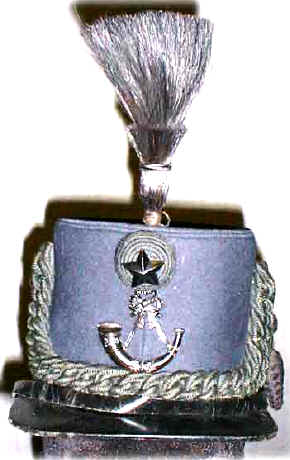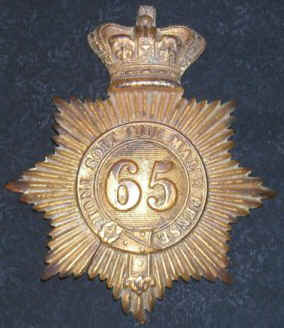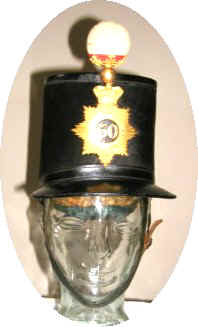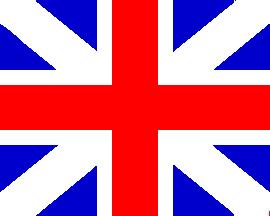 |
The British Army
in Australia
|
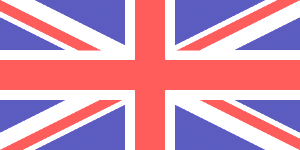 |
|
1788 - 1870
|
| When the Brits first
arrived in New South Wales they flew the square Union Flag that
represented England and Scotland. By the time they left the Union
had increased to include Ireland and the flag had got longer. Details |
Australia's military
history began in 1788 when four companies of the Marine Corps arrived
with the convicts in the First Fleet. Note that after 1820 they became
the Royal Marines. They served during these time frames
| 1788-1791 |
Sydney & Norfolk
Island |
| 1803-1812 |
Port Phillip & Van
Dieman's Land (Tasmania) |
| 1824-1829 |
Melville Island |
| 1837-1845 |
Port Essington |
| 1859-1913 |
Vessels of the Royal
Navy on the Australian Station |
| 1862-1870 |
Somerset, Cape York
Peninsular |
- The marines were mostly (not totally)
replaced by the New South Wales Corps (later the
102nd Regiment of Foot).
A small militia
detachment was raised at Norfolk Island as early as 1788, and again in
1792. Persistent rumours of a rising by Irish convicts in 1800 led to
the formation of Loyal Associations.
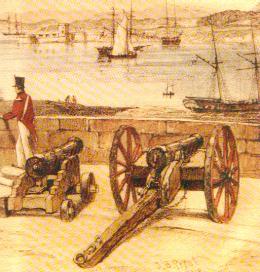 |
These Associations were formed, on
volunteer principles, at Sydney and Parramatta to assist, if necessary,
the New South Wales Corps. They remained in existence almost
continuously until 1810 due to the war with France and the convict
rebellion at Castle Hill.
To strengthen the defences of the colony Phillip directed Lieutenant
William Dawes to construct fortifications in the harbour and in July
1788 work commenced on a area at Sydney Cove now known as Bennelong
Point.
Two 6-pound guns, taken from HMS Sirius were set up in the
redoubt to provide protection to shipping. Later, Fort Maquarie was
built on this site. |
|
 New
Associate site with more detail British
Military in Australia New
Associate site with more detail British
Military in Australia
|
|
When the British marine forces returned to England in 1790 it was decided to create
a special force to garrison the new colony.
The New South Wales Corps
(now known as the Rum Corps) was raised under the command of Major
Francis Grose.
This unit drew heavy criticism for its involvement in the
rum trade but proved useful in putting down a convict uprising at Castle
Hill in 1804.
After the Rum Rebellion, which occurred on 26 January 1808, the
British Government sent Colonel Lachlan Macquarie to New South Wales
along with his own regiment, the 73rd Regiment of Foot, the Royal Highlanders.
All
the officers of the New South Wales Corps were returned to England in
disgrace in 1810.
|
 |
During its service, the New South Wales
Corps was criticised for the trading activities of some of its officers
and their constant quarrels with a succession of naval governors,
culminating in the deposing of the Governor, Captain William Bligh RN in
1808. Its military efficiency was such, however, that during the 1804
Castle Hill rebellion involving over 300 escaped convicts and others, a
company of the Corps marched from Sydney to Parramatta in about three
hours and, after a short rest, spent the remainder of the day subduing
the convicts.
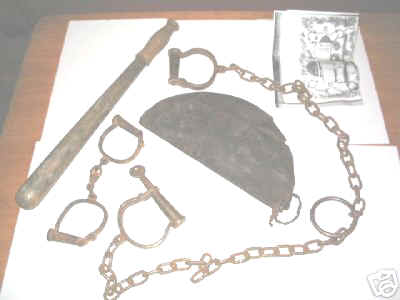 |
Convict / Bushranger era circa
1820-1850. Convict issue Leather "Scotch" or
"Glengarry" cap, government issue to convicts in Tasmania
and NSW. Split type with sides that folds down. Interior stamped with
B:O and broad arrow.
Also Leg irons, hand cuffs from the same
period.
Also wooden police / guards baton.
|
In 1809, Colonel Lachlan Macquarie
arrived as Governor, and the New South Wales Corps was replaced by his
own regiment - the 73rd. Thus began a succession of 26 British infantry
regiments, as well as a number of smaller artillery and engineer units,
to garrison the Australian colonies until the last was withdrawn in
1870.
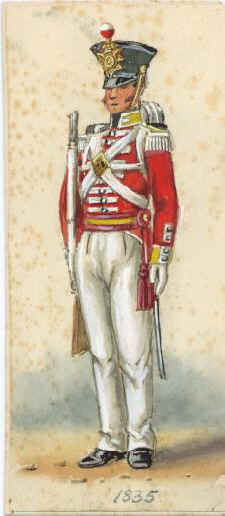 |
Their many duties were sometimes onerous.
Apart from those connected with the system of convict transportation,
both afloat and ashore, they established and maintained the Mounted
Police in New South Wales between 1825 and 1850.
The troops constructed
fortifications; attended fires and executions; assisted the police in
keeping the peace between rioting sailors, rival election parties and
squabbling sectarians.
They provided guards for wrecks, goldfields,
colonial treasuries, quarantine stations, government houses and the
opening and closing of legislatures and mounted escorts for gold in
transit.
They manned coastal defences and fired ceremonial artillery
salutes. They also operated intermittently against aboriginal resistance
in most of the colonies.
<<<Private soldier of the
28th Regiment of Foot in 1835
Some of these regiments also served on
active service in New Zealand during the Maori Wars.
|
They were also
deployed in aid of the Victorian Government during the uprising by gold
miners at Eureka, Ballarat in 1854, and again in 1861 in aid of the New
South Wales Government during racial riots at Lambing Flat.

The 73rd Regiment of
Foot (Re-enactment group) showing the uniforms and accoutrements of
the Regiment.
|
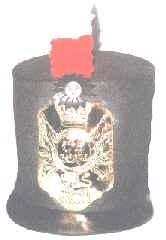
A stovepipe Shako; the headgear worn by the 73rd Regiment
|
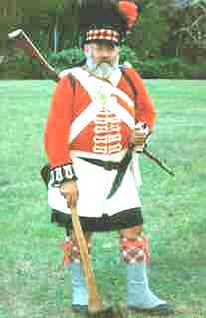 |
|
A soldier from the
Pioneer Section of the 42nd Royal Highland Regiment (re-enactment)
>>> |
British Regiments that served in Australia.
(and some locally raised Units)
|
Regt No:
|
Regiment Name:
|
From
|
To
|
Facing
colour
|
Loops
|
|
73rd
|
Royal Highlanders The
1st Battalion of the 73rd Regiment landed in Sydney on 1
January 1810 and took over duties from the New South Wales Corps
(102nd Regiment). It was thus the first of many British line
regiments that garrisoned New South Wales for the next sixty
years. When the 1st Battalion serving in New South Wales
completed its tour of duty in 1814 it was ordered to Ceylon,
where it remained until 1821.
|
1810
|
1814
|
dark green
|
square pairs
|
|
|
NSW Invalid Company
|
1810
|
1823
|
blue
|
single bastion
|
|
46th
|
South Devonshire The
46th Regiment arrived in Australia to replace the 73rd Regiment
1st Battalion Highland in February 1814,which was then relieved
by the 48th Foot The Northamptonshire Regiment in 1817. On the
11th of June 1813 the regiment sailed on board the transport
"Preston" for Portsmouth. Following its arrival at
Spithead, the Regiment received orders to proceed to Cowes in
the Isle of Wight. The regiment embarked on the 23rd of August
1813 on board the transports "Wyndham", "Three
Bees" and "General Hewitt" , and arrived at New
South Wales in February 1814. Following the Regiments Service
in New South Wales and on the 8th of September 1817 the
Regiment embarked in three divisions at Sydney Cove on board the
"Matilda", "Lloyd" and "Dick"
and arrived at Madras on the 16th of December 1817
|
1814
|
1817
|
Light yellow
|
single square
|
|
48th
|
Northamptonshire The
regiment was raised at Norwich and became known as Chomondely's
Regiment. The regiment was sent to Flanders to be part of
the Duke of Cumberland's army but was forced to return to
Scotland to be part of the Duke's forces to thwart the Jacobite
army's advance into England. It's first task was the
occupation of Edinburgh, which was successful and it remained
garrisoned in that city. It also served in North America
at Louisburg in 1758 and was at the capture of Quebec. The
Regiments tour of garrison duties in NSW extended to Van
Dieman's Land. One of the detachments founded the
settlement at Macquarie Harbour as a secondary place of
punishment for the worst convicts in the colony.
|
1817
|
1824
|
buff
|
square pairs
|
|
3rd
|
East Kent (the Buffs) Divided
into four detachments the Buffs were separated. First detachment
left Deptford for Sydney in 1821. Second detachment left
Deptford for Hobart 1822. The third detachment (The Buffs Head
Quarters) left Deptford for Sydney 1823, arriving the same year.
The fourth detachment arrived in Sydney in 1824 and were
stationed at Port Dalrymple, Parramatta, Liverpool, Newcastle,
Port Macquarie, Botany Bay and Bathurst . The Regiment reunited
and was transferred to Calcutta in 1827.
|
1823
|
1827
|
buff
|
square pairs
|
|
|
Royal NSW Veteran Companies
|
1825
|
1832
|
blue
|
square pairs
|
|
|
Royal Staff Corps
|
1826
|
1829
|
blue
|
|
|
40th
|
2nd Somersetshire 1823
- 1829 , Tasmania, Sydney . 1852 - 1860, Victoria, South
Australia & Swan River.
|
1824
|
1829
|
buff
|
square pairs
|
|
57th
|
West Middlesex Whilst
commanding a garrison in Australia, Captain Patrick Logan of the
57th discovered the Logan River and explored great tracts of
land. This was in 1826. There are still standing in Brisbane,
buildings that were erected by this officer who was killed by
the aborigines in 1830 whilst on an exploration expedition.
Another officer, Major Edmund Lockyer claimed, for Britain,
Western Australia, hoisting the Union Jack at King George Sound
on January 21st, 1827.
|
1825
|
1832
|
yellow
|
square pairs
|
|
39th
|
Dorset shire Arrived
in Australia toward the end of 1825. The Regiment saw service in
Hobart, Sydney, Western Australia & Bathurst, leaving on
July the 5th 1832 for service in India
|
1827
|
1832
|
pea green
|
square pairs
|
|
63rd
|
West Suffolk Served
in Tasmania, Sydney and Western Australia. Arrived on the
Sulphur in June 1829, the commencement of settlement in WA.
|
1829
|
1833
|
deep green
|
square pairs
|
|
17th
|
Leicestershire Arrived
during the latter part of 1830 through to 1831 seeing service in
Tasmania , Parramatta & Sydney. The Regiment was despatched
to Afghanistan and left Sydney in March of 1836
|
1830
|
1836
|
white
|
single square
|
|
4th
|
King’s Own Arrived
1832 relieved 1837 Stationed at Tasmania, Sydney, Victoria,
South Australia, Swan River.
|
1832
|
1837
|
blue
|
single bastion
|
|
|
Royal Engineers
|
1835
|
1870
|
blue
|
|
|
|
Royal Corps of Sappers & Miners
|
1835
|
1857
|
blue
|
|
|
50th
|
West Kent (Queen's Own) Stationed
at Sydney, Norfolk Island & Tasmania .
|
1833
|
1841
|
blue
|
pointed pairs
|
|
21st
|
Royal North British Fusiliers Arrived
during 1832 to 1833 seeing service in Sydney (staging only)
Hobart, Tasmania & Swan River. Transferred to Calcutta from
1839
|
1833
|
1839
|
blue
|
square pairs
|
|
28th
|
North Gloucestershire Arrived
during 1835 leaving for India in 1842 . The Regiment saw service
in Hobart, Sydney, Norfolk Island & Victoria.
|
1835
|
1842
|
yellow
|
square pairs
|
|
80th
|
Staffordshire Volunteers 13/11/1836
from Cork the 80th Regiment left for Sydney. This comprised of
only the first detachment. The remainder of the detachments
leaving Cork on the 18th of December 1838. Detachments were
deployed to Norfolk Island and some to New Zealand. Eventually
reuniting in Sydney in 1844, the Regiment sailed for India on
the 12th of August 1844.
|
1837
|
1844
|
yellow
|
pointed pairs
|
|
51st
|
2nd Yorkshire West Riding The
first detachment left Gravesend for Dublin in 1837 on board the
"Neptune" sailing for Tasmania. From Tasmania several detachments
sailed for Western Australia , Swan River and King George Town.
More divisions of the Regiment sailed on the "Runnymede" in 1839. The Regiment left in 1846 to serve in Bengal.
|
1838
|
1846
|
green
|
pointed pairs
|
|
96th
|
Manchester Regiment The
96th regiment was broken into 26 separate detachments in 1839.
These detachments began to arrive in Australia during 1839, with
the last detachment arriving in 1841. The headquarters for the
Regiment was one of the last detachments to arrive in 1841.
Throughout 1839 to 1841 the 96th Regiment acted as convict
Guards at several locations. The Regimental Head Quarters of
this Regiment was stationed in Windsor in 1841. In 1842 the
Headquarters moved to Parramatta and then to Launceston in 1843.
The Regiment remained in Tasmania until 1848 sailing to India in
January of 1849.
|
1841
|
1848
|
buff
|
square pairs
|
|
99th
|
Wiltshire Regiment (Lanarkshire) First
Detachment 99th Regiment of Foot came to Australia as a guard on
the convict ship "North Briton" which was bringing
convicts out to Tasmania in 1842. Second Detachment 99th Foot
Regiment came to Australia as a guard on the convict ship "John Renwick"
which was bringing convicts out to Tasmania
in 1842.Third Detachment 99th Foot Regiment came to Australia as
a guard on the convict ship "Kandahar" which was
bringing convicts out to Tasmania in 1842. After serving
sometime in the Parramatta area and also Port Phillip, they were
sent to New Zealand to engage the Maoris. 1842 saw the 99th
Regiment leave Chatham for Tasmania and arrived in Sydney 1843.
The 99th was a very unpopular Regiment with the 11th
Regiment being bought to Sydney to control the 99th. 1848 The
99th was stationed in Hobart and left Australia in 1856.
Stationed at Hobart, Sydney, Norfolk Island, Victoria, Moreton
Bay.
|
1843
|
1856
|
pale yellow
|
single square
|
|
58th
|
Rutlandshire In
1843 it was decided that the 58th Regiment ("The Black
Cuffs) should take over garrison duties in New South Wales from
the 80th which was going to Madras. The 58th provided the guards
for 19 convict ships that left London and Ireland for Tasmania
or Norfolk Island in 1842-45.In 1845 N.S.W. reluctantly agreed
to send the 58th to NZ because of the unrest with the Maori in
the Bay of Islands. The regiment stayed in NZ until November
1858 when they embarked for England, the Regiment then
consisting of 16 officers and 194 men . Over 300 officers and
men had elected to settle in NZ. During the years that the
Regiment was in NZ some detachments returned to Australia and
some took their discharge before this. In 1933, after many
temporary homes, the colours were placed in their final home,
the recently (then) completed Auckland War Memorial Museum where
they remain.
|
1844
|
1846
|
black
|
single square
|
|
11th
|
North Devonshire
The 1st/11th
Regiment (North Devonshire) was garrisoned in the colony from
1845 to 1857. The 99th Regiment was very unpopular in Sydney. It
was widely known for its rough and near mutinous behaviour. The
1st/11th Regiment was brought to Sydney from Van Dieman's Land
to control the riotous 99th Regiment. The first
division of the regiment containing headquarters and three
companies, sailed from Chatham aboard the "Castle Eden" in July
1845. The remainder of the regiment followed in the "Ramilies" in
August 1845 for Sydney. After service in Sydney they were
transferred to Hobart Town, returning in 1846 to restore
discipline in the unruly 99th Regiment. The 11th was a popular
regiment returning to garrison Sydney in response to a public
petition in 1848. The 11th occupied Victoria Barracks until they
returned to England in 1857.
|
1845
|
1857
|
deep green
|
bastion squares
|
|
65th
|
2nd Yorkshire North Riding Served
in Tasmania & Sydney
|
1846
|
1849
|
white
|
single square
|
|
40th
|
2nd Sommersetshire 1823
- 1829 , Tasmania, Sydney. 1852 - 1860, Victoria, South
Australia & Swan River.
|
1852
|
1860
|
buff
|
bastion pairs
|
|
12th
|
East Suffolk 1854:
one company of the 1st Battalion which had proceeded to Cork,
embarked there on the 18th January in the freight ship
"Gloucester" and sailed on 20th for Van Dieman's
Land. The second division of the Regiment, consisting of 2
Companies, under Captain Atkinson, embarked at Cork on board the
transport "Empress Eugenie" on the 28th July, and
disembarked at Melbourne on 6th November
|
1854
|
1861
|
yellow
|
bastion pairs
|
|
77th
|
East Middlesex
Served only in Sydney
|
1857
|
1858
|
yellow
|
|
|
50th
|
West Kent
(Queen's Own) On their second tour.
|
1866
|
1869
|
blue
|
|
|
14th
|
Buckinghamshire 2nd
Battalion of the 14th Regiment arrived in 1867, seeing service
in Tasmania, Sydney, Victoria & Swan River.
|
1867
|
1869
|
buff
|
|
|
18th
|
Royal Irish The
2nd Battalion of the Regiment arrived from New Zealand in March
of 1870 seeing service in Tasmania, Sydney, Victoria & South
Australia. The Regiment began its return to England in August of
1870 with the last of the Regiment leaving on the 6th of
September 1870
|
1870
|
1870
|
blue
|
|
|
|
-
Royal Artillery
-
#2
Company, 6 Battalion 1843 - 1846. Sydney.
-
#3 Company, 7
Battalion : Sydney 1856 - 1865 .
-
#1 Battery : 15 Brigade 1861 -
1868 Melbourne.
-
#1 Battery, 1 Brigade : 1868 - 1870 Sydney.
|
1843
|
1870
|
red
|
|
|

